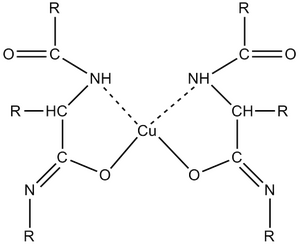Total protein
Determination of total serum protein is a common and accessible method. Examination of the concentration of total protein in the serum provides us with indicative information about the biosynthesis, utilization and excretion of proteins. A change in the composition of serum proteins is caused by various diseases, but only some are manifested by a deviation in the values of the total protein.
The concentration of total protein in the serum can be affected by the following basic factors:
- hydration status;
- altering the biosynthesis of one or more specific proteins;
- rate of loss of one or more specific proteins.
Hypoproteinemia[edit | edit source]
Hypoproteinemia is a term for a reduced concentration of protein in the serum.
Absolute hypoproteinemia occurs as a result of a reduced amount of protein in the serum due to:
- increased losses by:
- kidneys;
- gastrointestinal tract (e.g. intestinal inflammation);
- skin (burns);
- bleeding;
- to "third space" (e.g. into the abdominal cavity during ascites);
- reduced protein synthesis in the liver (chronic liver diseases);
- insufficient protein intake in the case of nutritional disorders.
In relative hypoproteinemia, the normal amount of proteins is preserved, but due to the retention of water and electrolytes, they are "diluted" (state of hyperhydration ). The concentrations of individual proteins are reduced in the same proportion.
Hyperproteinemia[edit | edit source]
Hyperproteinemia means an increased concentration of total protein in the serum.
Absolute hyperproteinemia is an increase in protein concentration usually caused by increased synthesis of some specific proteins, e.g. immunoglobulins (plasmocytoma).
Relative hyperproteinemia occurs as a result of dehydration of the organism due to insufficient intake or excessive loss of fluids (severe diarrhea, vomiting). The total amount of proteins is preserved and the concentration of individual proteins is increased proportionally.
Principle of determination of total protein[edit | edit source]

The total protein in the serum is determined by the biuret reaction.
In an alkaline environment in the presence of copper salts, proteins give a purple color, suitable for photometric determination [2][3]. In simple terms, it can be said that complex compounds of Cu2+ with ions of peptide bonds are formed [4]. The resulting complex strongly absorbs light in the 540–560 nm range. The colour intensity of the complex is measured photometrically and is directly proportional to the protein concentration. The biuret reaction is generally provided by substances containing at least two peptide bonds (-CO-NH-) or two -CO-NH2 groups in the molecule. Thus, the reaction is not specific only to proteins. The simplest compound reacting with copper salts in an alkaline environment is a biuret containing two peptide bonds. Amino acids and dipeptides do not react.
A part of the biuret reagent is copper sulfate, which provides Cu2+ for the formation of complexes with peptide bonds, and an alkalizing component (hydroxide), which converts the peptide bond to the enol form and thus allows the participation of oxygen atoms in the complex. Other components of the reagent are potassium sodium tartrate, which prevents the precipitation of Cu 2+ to Cu(OH)2 as a complexing agent, and potassium iodide, which protects Cu2+ from autoreduction. The sensitivity of the biuret method is around 1-10 g protein/l.
Reference range: Serum total protein concentration (S-total protein): 65-85 g/l
Links[edit | edit source]
Related articles[edit | edit source]
- Plasma proteins
- Protein in blood and urine
Reference[edit | edit source]
- ↑ STRICKLAND, RD, ML FREEMAN a FT GURULE. Copper binding by proteins in alkaline solution. Analytical chemistry [online]. 1961, vol. 33, no. 4, s. 545-552, dostupné také z <https://pubs.acs.org/action/cookieAbsent>. ISSN 0003-2700. DOI: 10.1021/ac60172a019.
- ↑ DOUMAS, B T. Standards for total serum protein assays--a collaborative study. Clin Chem [online]. 1975, vol. 21, no. 8, s. 1159-66, dostupné také z <https://www.ncbi.nlm.nih.gov/pubmed/1169135>. ISSN 0009-9147.
- ↑ DOUMAS, B T, D D BAYSE a R J CARTER, et al. A candidate reference method for determination of total protein in serum. I. Development and validation. Clin Chem [online]. 1981, vol. 27, no. 10, s. 1642-50, dostupné také z <https://www.ncbi.nlm.nih.gov/pubmed/6169466>. ISSN 0009-9147.
- ↑ STRICKLAND, RD, ML FREEMAN a FT GURULE. Copper binding by proteins in alkaline solution. Analytical chemistry [online]. 1961, vol. 33, no. 4, s. 545-552, dostupné také z <https://pubs.acs.org/action/cookieAbsent>. ISSN 0003-2700. DOI: 10.1021/ac60172a019.
Kategorie:Vložené články
Kategorie:Biochemie
Kategorie:Klinická biochemie
